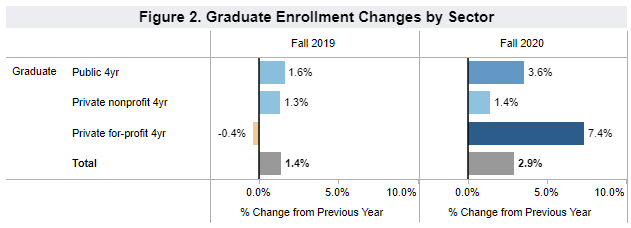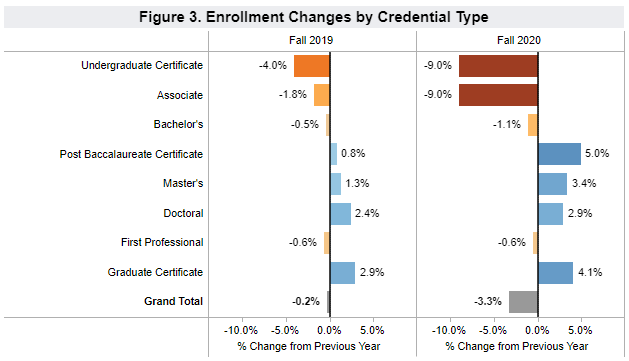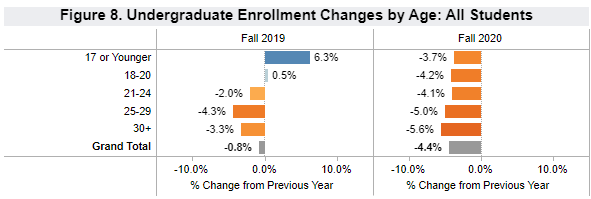enrollment
Triumphs and Challenges for Graduate, Adult, and Online: What the Data Tell Us About the Future

I’ve been following the monthly releases of fall 2020 adult, online, and graduate enrollment trends data from National Student Clearinghouse (NSC) with an eagerness rarely felt, and understand why accompanying news stories have largely focused on the obvious challenges they outline for undergraduate education generally and community college education in particular. While these are serious issues, they mask some important developments elsewhere in the sector—representing specific opportunities (perhaps even triumphs!) and challenges for graduate, adult undergraduate, and online audiences.
These important developments are displayed in three charts from the National Student Clearinghouse data released on November 11.
Graduate Enrollment: Up
With each monthly release (now representing 75 percent of all institutions) the outlook for graduate enrollment has gotten stronger. Overall, graduate enrollment trends show a rise of 2.9 percent (up from 2.7 last month). This is driven by newly reported increases among private non-profit institutions (up 1.4 percent compared with no growth reported last month). This more than offsets a lower estimate among for-profit institutions (7.4 percent compared with 9.3 percent reported in October) driven by more diverse start dates that did not allow for a complete picture earlier on. These findings demonstrate that while for-profit institutions are well positioned to capitalize on increased demand for remote and online learning, they are by no means the only group of schools to benefit from an otherwise a pretty awful situation.

Certificates: Graduate Up, Undergraduate Down
The imminent expansion of both supply and demand for non-degree credentials has been discussed at every conference I have attended for the last several years. The undergraduate certificate in all its permutations of length and depth has been a particular focus of discussion for adult students. However, this is likely not the time to move in this direction. Undergraduate certificates were the biggest losers this fall, with a 9 percent decline in enrollment in 2020. This follows a 4 percent decline in fall 2019. This may be part of a larger trend that speaks to upcoming challenges in adult undergraduate enrollment (which we will discuss in another future blog post).
Post-baccalaureate and graduate certificates demonstrated the greatest growth among all credentials this fall—5 percent for post-bac certificates (after just 0.8 percent growth in 2019) and 4.1 percent for graduate certificates (building on 2.9 percent growth in 2019). This is a strong indicator that at the graduate level, institutions are wise to move forward with these non-degree alternatives as more and more working (and non-working) professionals realize that they may not need a master’s degree for their next career move, but do indeed need some additional education. In a blog in early 2021 we will explore what the Chronicle of Higher Education recently described as the “educational divide” in the US that may help to explain the growth of graduate education at the same time we are seeing a decline in adult undergraduate education.

Adult Undergraduate: Down
Data on adult participation in undergraduate education may indeed be driven by what may becoming an American “educational divide.” Enrollment of individuals ages 25-29 declined by 5 percent (following a 4.3 percent decline in 2019) while those aged 30+ declined 5.6 percent (following a 3.3 percent decline in 2019). This is an unfortunate development in general, but particularly at a time when institutions have already begun the “pendulum swing” back to such a focus as they see troubling signs in undergraduate traditional enrollment. (This is at least the third time I’ve seen this swing in my 25-year career.)
Here’s the real trick: as more institutions than ever before turn (or return) their attention to adult students, there seem to be fewer older students pursuing higher education than ever before. For many campuses, this challenge is further compounded by a fairly small set of institutions that have become very effective at adult undergraduate recruitment (such as Southern New Hampshire University and Western Governor’s University), increasing the difficulty of competing for this student population.

Three priorities based on these adult, online, and graduate enrollment trends
In light of these data results, here are three areas of focus to consider:
- Graduate education in general
- Graduate non-degree education specifically (although noting that master’s enrollment was also up 3.3 percent)
- Undergraduate adult students (although noting that overall numbers are down)
All three present distinct opportunities for institutions that are nimble enough to engage these populations and capable of mounting sophisticated marketing and outreach efforts that speak to the priorities of these students and reach them where they can be found. This is a heavy lift, but one that could definitely materially contribute to enrollment growth in very trying times.
The missing piece here, of course, is the role that online education will play in the near- to mid-term future health of our institutions. While no report has yet been released specifically on online enrollment trends, NSC has also released data on enrollment at “primarily online institutions” (institutions that report 90+ percent of their enrollment to NCES as exclusively enrolled in distance learning). These institutions (about 35 in total) reported growth of 4.9 percent at the undergraduate level and 9.7 at the graduate level. As more and more students enroll in online study, their demands that it be of the highest possible quality—with pedagogy appropriate to the online format—will only increase.
I hope that, like me, you feel positive about the opportunities illustrated by these adult, online, and graduate enrollment trends. My colleagues and I stand ready to assist you on any of these fronts—from helping to develop and execute state-of-the-art digital marketing campaigns to developing the very highest quality online courses (our newest offering). Contact us and we can set up a time to talk.
Talk with our graduate and online enrollment experts
Ask for a free consultation with us. We’ll help you assess your market and develop the optimal strategies for your prospective graduate students and online learners.
